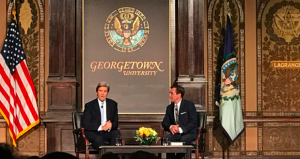The fashion industry is one of the most polluting sectors in the world, responsible for 10 percent of all carbon emissions and 20 percent of global wastewater. In response, some Georgetown students are promoting sustainable clothing practices in their own community through fashion reuse.
Georgetown Renewable Energy and Environmental Network (GREEN), the university’s largest environmental student organization, hosted a clothing swap on Oct. 10 for students to exchange clothing they no longer wanted. GREEN’s swap aimed to reduce clothing waste while also allowing students to get new clothes for free.
“Clothing produces a lot of waste,” Rita Alan (COL ’24), a member of GREEN who helped run the swap, said. “We wanted to do something about all the waste from throwing out clothes on campus.”
While most clothing swaps require each participant to bring something to exchange in order to take something away, GREEN says their standards are more lax. “People have been coming and dropping off clothes they don’t want anymore and looking at clothes that are here,” Alan said. “Everyone is welcome to take clothes regardless of whether they bring anything or not.” The club loosened its definition to ensure as much participation as possible while also making sure that a surplus of clothes were not left over.
The average American throws away around 81 pounds of clothing each year. For all discarded clothing, 57 percent ends up in landfills, where synthetic plastics in cheap fabrics wreak havoc on the environment. These plastics can end up in the ocean and take a long time to dissolve, damaging marine life and contributing to climate change.
Although donating to thrift stores seems like a good way to reduce clothing waste, most donations are thrown away if they are not sold within a certain amount of time. Unwanted clothing from U.S. thrift stores are sent to other countries, such as Pakistan and Malaysia, and if the clothing is in unusable condition, it is shredded and used as insulation. Clothing sold overseas can also harm local clothing markets, often displacing regional businesses.
Fast fashion brands such as Shein, Zara, and Forever 21 have immensely increased in popularity over the past few years and exacerbated the waste problem. Fast fashion is cheap clothing that is produced as quickly as possible to keep up with the ever-changing trend cycles and high rates of consumption. Since these clothes need to be made rapidly and inexpensively for the companies to keep their business models, they are often produced in poor conditions with shabby materials. Made quickly and carelessly, their lifespan is much shorter than more sustainably created clothing. All the harm the fashion industry contributes to the environment has inspired groups like GREEN combating climate change to formulate creative opportunities for people to buy clothes secondhand and shop sustainably.
In addition to the clothing swap, GREEN has other initiatives to promote sustainability on campus. It currently has six teams: gardening, zero waste, education, energy and water, environmental justice, and bees—a group that takes care of and harvests honey from beehives on campus.
“Our main goal is to increase sustainable practices within student life and bring sustainable education to campus and also advocate for more sustainability with administration,” GREEN President Anu Lamsal (SFS ’23) said in an interview with the Voice. In the past, the club has hosted events and educational projects to promote more sustainable practices on campus.
This was not GREEN’s first successful clothing swap. In summer 2021, GREEN members who were living in D.C. traded clothing and, given the large number of people who participated in the swap on Oct. 10, GREEN believes that Georgetown students are excited about the initiative and will continue to partake in future swaps.
GREEN plans to pursue more initiatives to further their mission of reducing waste on campus. “As an offshoot from the clothing swap, we’re hoping to start up a pop-up thrift store,” Lamsal said. “We had a lot of clothes leftover from the clothing swap and we don’t want to waste them. We thought that if we could source [clothing] from Georgetown students, and then sell it back to other students, we could reduce textile waste in that way and it would be really effective.”
Getting affordable secondhand clothing is important for many students who can’t buy new clothing, especially in a city where even local thrift stores can be expensive, according to Alan. “It’s pretty difficult to thrift in the D.C. area. Most places are pretty far away, and the options, especially in D.C., are very limited and more expensive,” she said.
Club members plan to have an on-campus thrift pop-up running by early next semester. GREEN will collect donations from students which will then be gathered and sold at the pop-ups for affordable prices. All proceeds will go to Georgetown Mutual Aid, a student-run organization that manages community donations to other students. The details of the pop-up have not been fully figured out, but it will happen sporadically on campus, where students can easily engage in this sustainable fashion practice.
Initiatives like GREEN’s clothing swap help both students with sustainability in mind as well as those who would benefit from low-cost or free clothing alternatives. The thrift store revenue will be another channel to redistribute resources among students.
Combatting fast fashion is a priority of GREEN, and members plan on hosting educational events about the fashion industry and its contribution to climate change. “Our education team is going to take on some projects regarding clothing waste education, and I think they’re hoping to take on a poster campaign about clothing waste, textile waste, fast fashion,” Lamsal said.
With these upcoming initiatives and events, GREEN hopes to inspire more people to buy secondhand and to be more mindful of their shopping habits, as well as to be aware of the serious harm the fashion industry causes to the climate.





